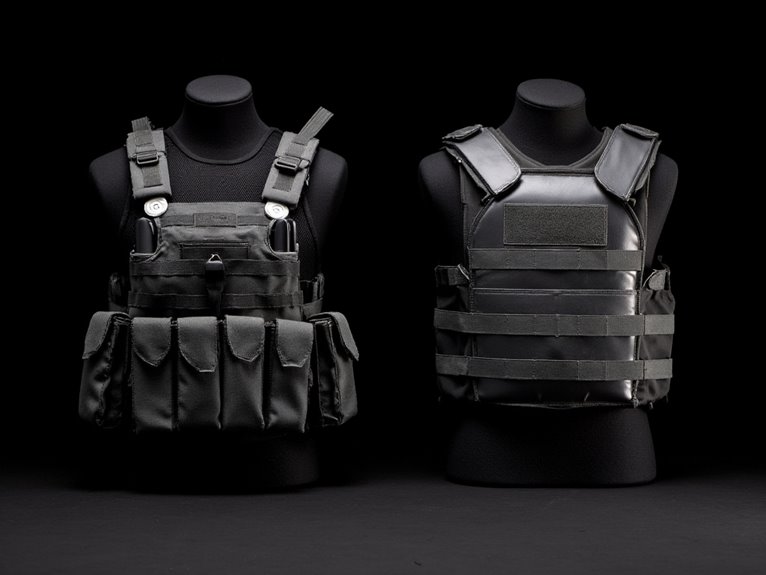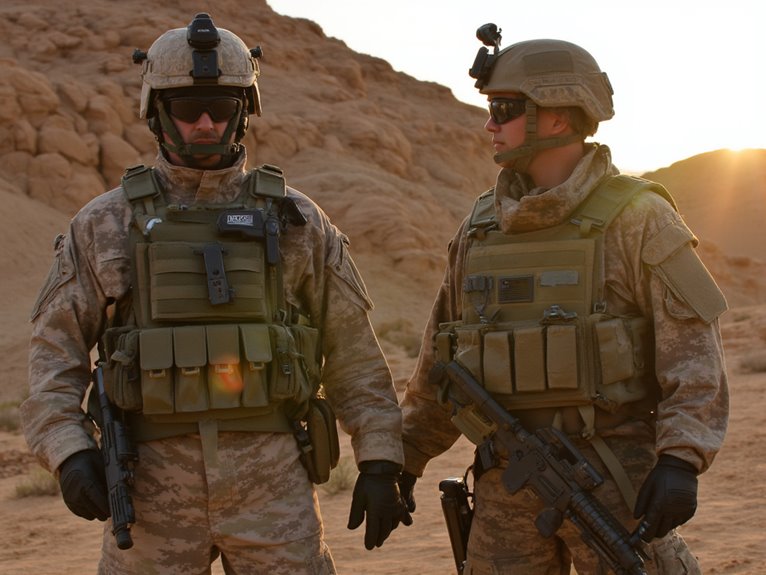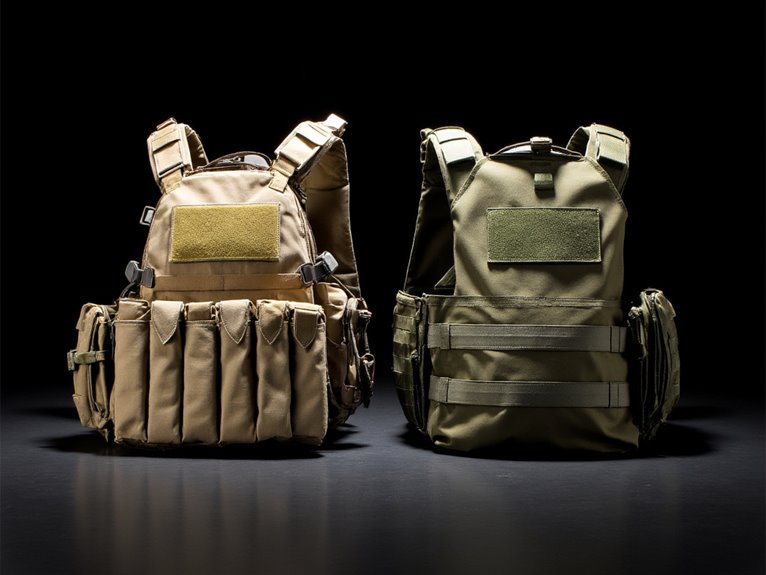Tactical Chest Rigs vs. Plate Carriers: Key Differences and Use Cases
Chest rigs prioritize gear organization and mobility, weighing 2-4 pounds without ballistic protection, making them ideal for reconnaissance and patrol operations. Plate carriers provide essential ballistic defense through hard armor plates but exceed 20 pounds when fully equipped, restricting movement while offering combat-level protection. You’ll find chest rigs excel in low-threat environments requiring speed and endurance, while plate carriers dominate high-threat scenarios where survivability outweighs mobility concerns. Understanding these fundamental distinctions will guide your best equipment selection.
We are supported by our audience. When you purchase through links on our site, we may earn an affiliate commission, at no extra cost for you. Learn more. Last update on 27th December 2025 / Images from Amazon Product Advertising API.
Notable Insights
- Plate carriers provide ballistic protection with hard armor plates while chest rigs prioritize gear organization without ballistic defense.
- Chest rigs weigh 2-4 pounds compared to plate carriers exceeding 20 pounds, significantly impacting mobility and endurance.
- Plate carriers excel in high-threat combat environments; chest rigs are ideal for reconnaissance and patrol missions requiring speed.
- Both systems feature MOLLE webbing for customization, but plate carriers have reduced gear space due to armor integration.
- Chest rigs cost less overall without requiring expensive ballistic plates that plate carriers need for protection capabilities.
Protection Capabilities and Primary Functions
When evaluating tactical gear for field operations, the fundamental distinction between chest rigs and plate carriers lies in their core protection philosophy.
Plate carriers prioritize ballistic effectiveness through hard armor plate integration, stopping rifle rounds and shrapnel in direct combat scenarios. You’ll find these systems standard among military infantry and tactical law enforcement units where projectile threats are imminent.
Chest rigs focus on equipment organization rather than ballistic defense. They’re designed for mission readiness in low-threat environments where mobility outweighs protection needs. You won’t get armor capability, but you’ll gain unrestricted movement and rapid gear access. The lighter construction of chest rigs makes them significantly more comfortable for extended wear during prolonged operations.
The protection level determines your operational context. Choose plate carriers for hostile zones requiring life-saving defense. Select chest rigs for reconnaissance, surveillance, or extended patrols where speed and endurance matter most. Both systems feature MOLLE webbing for attaching pouches, holsters, and medical kits to customize your loadout.
Weight, Mobility, and Comfort Considerations

Three critical factors separate chest rigs from plate carriers in field performance: weight distribution, movement capability, and user comfort during extended operations.
Chest rigs typically weigh 2-4 pounds without ballistic plates. Plate carriers exceed 20 pounds when fully equipped with armor. This weight difference directly impacts your endurance and heat stress tolerance.
The 16+ pound weight differential between chest rigs and fully-loaded plate carriers significantly affects operator endurance and thermal management.
Design features in chest rigs prioritize mobility through minimalist construction and breathable materials. You’ll experience superior agility for reconnaissance missions requiring rapid movement.
Plate carriers sacrifice mobility for protection but can restrict movement in confined spaces. Their bulk interferes with layering systems and ventilation. User preferences often depend on threat level versus operational requirements.
Chest rigs excel in hot climates due to reduced heat retention. However, comfort diminishes considerably in plate carriers due to pressure points from heavy armor plates. The MOLLE webbing configuration allows both systems to accommodate customized loadouts based on specific mission requirements.
Plate carriers distribute the weight of gear across the torso, making them more comfortable for extended missions despite their heavier overall load.
Load Capacity and Modular Customization Options
Although both systems accommodate additional gear, chest rigs and plate carriers approach load management through fundamentally different design philosophies. Chest rigs prioritize maximum gear capacity through multiple pouches and pockets, enabling superior organization without armor constraints. You’ll find distribution efficiency varies greatly between platforms.
Plate carriers integrate armor plates, reducing available space but offering moderate load capacity through MOLLE attachment systems.
Customization options differ considerably based on user preferences. Plate carriers provide high modularity with interchangeable armor compartments and extensive MOLLE compatibility for mission-specific configurations. You can swap protection levels while maintaining tactical capability.
Chest rigs emphasize gear accessibility through fixed or modular arrangements, prioritizing non-ballistic equipment carriage. Their lightweight construction enables easy component swapping for different operational roles, maximizing load potential without ballistic protection constraints. Both platforms often integrate retention holsters to ensure secure firearm access while maintaining operational flexibility.
Operational Applications and Mission-Specific Roles

Understanding these design differences becomes particularly relevant when you examine how each platform performs across different operational scenarios.
Plate carriers dominate high-threat environments where ballistic protection is essential. Military infantry and SWAT teams rely on them during direct combat encounters and urban warfare operations. Their tactical advantages include rifle-rated protection and modular expansion capabilities for extended missions.
Chest rigs excel in reconnaissance, patrol operations, and security roles where mobility trumps protection. Special forces prefer them for long-range movements requiring speed and endurance.
User preferences typically favor chest rigs for training exercises and support roles.
Training scenarios and support operations consistently drive users toward chest rigs over heavier plate carrier alternatives.
Mission parameters ultimately determine platform selection. High-risk tactical interventions demand plate carriers’ protective capabilities, while rapid-response scenarios benefit from chest rigs’ lightweight agility and streamlined equipment access.
Cost Factors and Equipment Compatibility
Budget considerations substantially impact tactical gear selection, with plate carriers commanding premium prices that often exceed $300 for quality models like the Crye Precision JPC 2.0 at $319.
You’ll face additional costs for ballistic plates, which considerably increase total investment compared to chest rigs that don’t require armor plates.
Material durability drives higher manufacturing costs in plate carriers.
Advanced fabrics and reinforced construction handle armor weight and repeated stress.
Chest rigs use simpler materials, reducing base prices.
Equipment compatibility varies between platforms.
Both systems support modular design through MOLLE/PALS webbing, but plate carriers accommodate heavier loads with stronger suspension systems.
You’ll find chest rigs prioritize lightweight pouches for ammunition and communication gear.
Plate carriers integrate armor-compatible accessories like side panels and zip-on extensions, balancing protection with load-carrying capability.
On a final note
Your choice between tactical chest rigs and plate carriers depends on mission requirements and threat levels. You’ll select chest rigs for lightweight operations requiring maximum mobility and equipment access. You’ll choose plate carriers when ballistic protection is essential, despite increased weight and bulk. Consider your budget, compatibility with existing gear, and specific operational needs. Both platforms offer modular customization, but they serve fundamentally different tactical roles in your equipment configuration.

